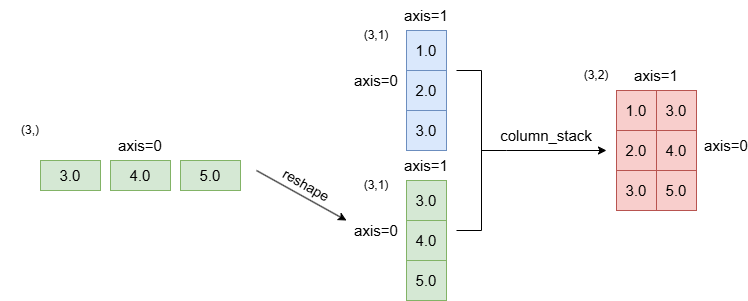column_stack
沿水平轴堆叠输入 x 中的所有张量。 x 中的每个张量 tensor 如果在堆叠之前 tensor.ndim < 2 ,则首先被整形为 (tensor.numel(), 1)。所有张量必须具有相同的数据类型。
下图展示了一个 column_stack 的情形,将一个形状为(3,1)的二维张量与一个形状为(3,)的一维张量进行 column_stack 操作,其中一维张量首先被整形为(3,1),然后再沿水平轴堆叠输入所有张量。通过图例能很好看出张量的变化。

参数
x (list[Tensor]|tuple[Tensor]) - 输入
x可以是张量的 list 或 tuple,x中张量的数据类型必须相同。支持的数据类型:float16、float32、float64、int32、int64或bfloat16。name (str,可选) - 具体用法请参见 api_guide_Name,一般无需设置,默认值为 None。
返回
Tensor,与输入数据类型相同的堆叠张量。
代码示例
>>> import paddle
>>> # column_stack with 0-D tensors
>>> x1 = paddle.to_tensor(1.0)
>>> x2 = paddle.to_tensor(2.0)
>>> out = paddle.column_stack((x1, x2))
>>> print(out)
Tensor(shape=[1, 2], dtype=float32, place=Place(cpu), stop_gradient=True,
[[1., 2.]])
>>> # column_stack mix with 1-D & 2-D tensors
>>> x1 = paddle.to_tensor([[1.0], [2.0], [3.0]])
>>> x2 = paddle.to_tensor([3.0, 4.0, 5.0])
>>> out = paddle.column_stack((x1, x2))
>>> print(out)
Tensor(shape=[3, 2], dtype=float32, place=Place(cpu), stop_gradient=True,
[[1., 3.],
[2., 4.],
[3., 5.]])
>>> # column_stack with 3-D tensors
>>> x1 = paddle.to_tensor([[[1.0, 2.0], [3.0, 4.0]]])
>>> x2 = paddle.to_tensor([[[3.0, 4.0], [5.0, 6.0]]])
>>> out = paddle.column_stack((x1, x2))
>>> print(out)
Tensor(shape=[1, 4, 2], dtype=float32, place=Place(cpu), stop_gradient=True,
[[[1., 2.],
[3., 4.],
[3., 4.],
[5., 6.]]])